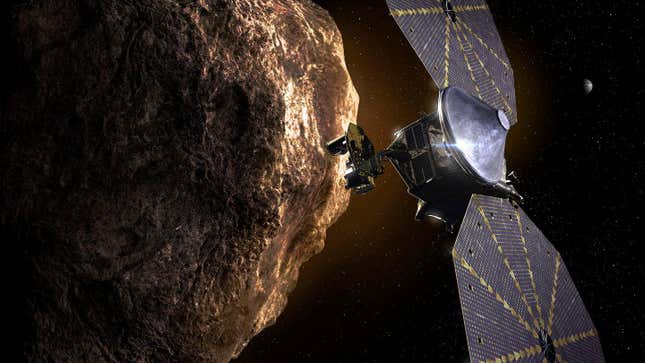
NASA engineers installed a time capsule on the Lucy spacecraft late last week, intended for future astro-archaeologists to retrieve and interpret. The time capsule is a plaque that includes messages from Nobel Laureates and musicians, among others, as well as a depiction of the solar system’s configuration on October 16, 2021, the date the spacecraft is expected to launch.
Like the Pioneer and Voyager probes, Lucy will carry a message to whoever may eventually intercept the craft. But while the previous probes have messages meant for aliens, as they were shot toward interstellar space, Lucy will stay within the solar system. Its time capsule will presumably be for future humans to retrieve, hence the inclusion of words from Nobel Laureates, Poet Laureates, and musicians, according to a NASA release detailing the plaque’s inclusion. The plaque was installed on Lucy in Colorado on July 9, where the craft is undergoing final preparations before its slated autumn launch.
The plaque includes quotes from civil rights leader Martin Luther King Jr., authors and poets including Orhan Pamuk, Louise Glück, Amanda Gorman, Joy Harjo, and Rita Dove, scientists Albert Einstein and Carl Sagan, and musicians including all four Beatles and Queen guitarist and astronomer Brian May. The messages discuss hope, love, the heavens, cultural memory, and eternity. A complete list can be found on Lucy’s website.
Lucy’s mission focuses on the Trojan asteroids, a group of space rocks that orbit the Sun beyond the ring of the asteroid belt, taking turns leading Jupiter or chasing the gas giant in its own solar orbit. (Trojan asteroids are those that share an orbit with a planet and often are byproducts of that planet’s formation, but the term most commonly applies to those involved with Jupiter.) Jupiter has a phalanx of Trojans, but Lucy (named for the fossil hominin, itself named for the Beatles song Lucy in the Sky with Diamonds) is targeting just seven of them for flybys over the course of 12 years.
The asteroids are intriguing because they’re thought to have formed in the early solar system; just as the Lucy fossil helped paleoanthropologists understand human evolution, the hope is that the Lucy spacecraft will inform NASA about solar system evolution. And since Lucy’s in the sky—beyond it, if we’re being extremely literal—you can imagine the “diamonds” here are the asteroids, a veritable wealth of information.

Lucy is a product of the Discovery Program, the NASA initiative that is producing the DAVINCI+ and VERITAS missions to Venus. The Lucy mission will conclude in 2033, around the same time those spacecraft are getting to Venus, but Lucy will bounce between the Trojans and Earth for at least hundreds of thousands of years (NASA has no plans to snatch the craft back out from space).
Perhaps the most apt passage on the plaque, then, is a quote from science journalist Dava Sobel: “We, the inquisitive people of Earth, sent this robot spacecraft to explore the pristine small bodies orbiting near the largest planet in our solar system. We sought to trace our own origins as far back as evidence allowed. Even as we looked to the ancient past, we thought ahead to the day you might recover this relic of our science.”
To the future humans who may nab Lucy: Enjoy your plaque. You probably won’t be using any language currently spoken on Earth, but hopefully you can grok our intent.
More: NASA Is Sending a Probe to Explore Jupiter’s Mysterious Trojan Asteroids